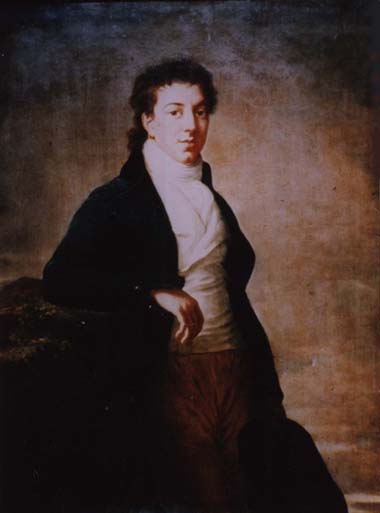

It has to be said that the St John men didn’t always make model husbands. Those who married into the family were also something of a mixed bunch – but when Anne Judith St John Mildmay married William Pleydell-Bouverie she definitely secured one of the good guys.
Born in 1779 the young William Pleydell-Bouverie, Viscount Folkestone and later 3rd Earl of Radnor, was educated in France and presented at the court of Louis XVI and his Queen Marie Antoinette.
Having witnessed the early days of the French Revolution you might have expected that on his return to England William would pull up the drawbridge at the ancestral home of Longford Castle near Salisbury, keeping his head down and his neck well protected. Instead he whole heartedly embraced social reform and became a staunch supporter of popular rights, championing the cause of the impoverished agricultural worker. He befriended the irascible radical reformer William Cobbett and was famously declared to be the only man with whom Cobbett never quarrelled.
Cobbett stopped off at Coleshill to visit his old friend and to have a look at the Locust trees during his epic journey across England in 1826. William had planted 13,600 trees, which Cobbett described as ‘the most beautiful clumps of trees that I ever saw in my life.’
He also took a turn around ‘the most complete farm yard that I ever saw.’ He continues: ‘And here, too, there is no misery amongst those who do the work; those without whom there could have been no Locust-plantations and no farm-yard. Here all are comfortable; gaunt hunger here stares no man in the face.’
William was among those who opposed the imposition of the 1815 Corn Laws, a tax on cheap foreign imports of grain to protect the home grown market, the effect of which was a catastrophic increase in the price of bread.
But what about Anne?
William’s second wife Anne Judith St John Mildmay was the daughter of Henry St John Mildmay 3rd Baronet and Jane Mildmay and grew up at the family seat of Dogmersfield in Hampshire.
Anne and William married at that celebrity wedding venue, St George’s, Hanover Square on May 24, 1814. Between 1815-1825 Anne gave birth to five children. A still born son was born in 1832. The couple divided their time between their London home and their country residence at Coleshill House, Berkshire.
Built in the 17th century for Sir George Pratt, Coleshill was the first house to be built for a ‘minor’ gentleman in the classical manner. The plan of the house combined convenience with advanced designs of architecture. Innovations included a corridor for separate access to all rooms and back stairs for the use of servants. Rooms were grouped in suites in the French appartement system.
Sir George Pratt’s daughter Mary married Thomas Pleydell of Shrivenham in 1666 and eventually inherited the Coleshill estate. The Bouverie connection came when Harriet, the daughter of Sir Mark Stuart Pleydell married William de Bouverie, 1st Earl of Radnor on January 14th 1747/48. The property would remain in the Pleydell Bouverie family for almost 200 years.
But, again, what about Anne? She still doesn’t figure very prominently in the great scheme of things.
Thomas Creevy MP for Downton with William’s younger brother Philip, who left a wealth of paperwork on 19th century society, makes a reference to the Mildmay ladies in a letter to his stepdaughter Elizabeth Ord dated June 23, 1834.
“We had a most jolly day and very good company. Mrs Methuen is a sister of Ly. Radnor, and a great improvement upon her – I don’t mean in morals; I know nothing upon that subject, except that the parent female stock, who was there in the evening, had been somewhat slippery in her day.”
Ouch! Although it sheds little light on Lady Radnor, the reference to her mother is intriguing.
Anne doesn’t even receive a mention in her mother’s will, possibly because a financial settlement had been made on her at the time of her marriage. However it is surprising she wasn’t bequeathed a personal memento, especially as Jane appeared to have an abundance of repeating watches to give away.
William retired from politics in 1848 to concentrate on improving the estate farm at Coleshill. Here he commissioned new premises to maximise the improvement programme at Court Leaze Farm.
At the time of the 1851 census Anne is at home at Coleshill House. With her on census night was her unmarried daughter Mary Pleydell-Bouverie, two visitors and twenty-eight servants. The indoor staff included housekeeper, cook, a butler, under butler and two footmen and just three housemaids to sweep, dust and polish. Perhaps his Lordship’s proud principles slipped a bit ‘indoors.’
Anne died at Coleshill House on April 27, 1851. William survived her by 18 years. He died on April 9, 1869 and was buried at Britford parish church, close to Longford Castle.
During renovation work in 1952 a blow lamp used to remove old paintwork from dormer windows set fire to the magnificent 17th century Coleshill House. As the fire took hold, farm and estate workers along with Coleshill village residents rushed to the house and began the frantic task of removing the contents. Valuable paintings, furniture and books were all saved. What little remained of the building was later demolished.
Perhaps among the rescued artwork was a portrait of Anne?